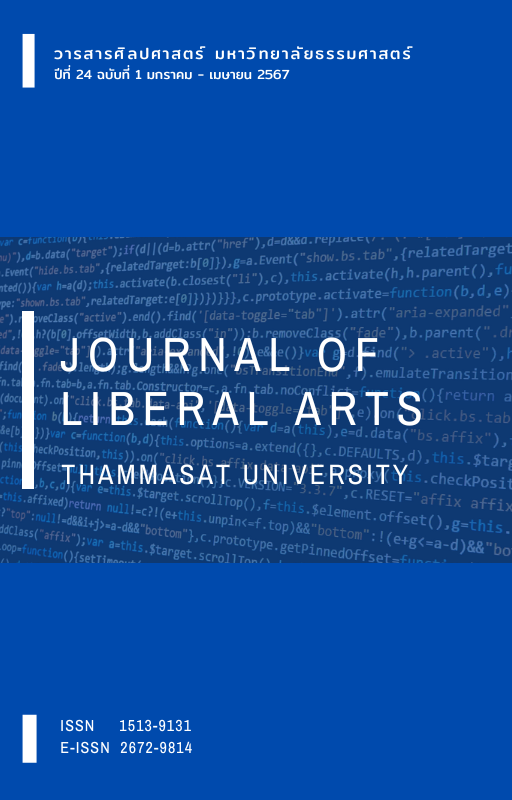Representation of Westerners in the novel Siamese Tears
Main Article Content
Abstract
The purpose of this research article is to explore the representation of Westerners in the novel Siamese Tears, written by Claire Keefe-Fox, a French-American writer, using the concepts of representation and orientalism as the frameworks of this study. The results of the study revealed that the novel represents a picture of Westerners in the 19th century who underwent a change of thought. Originally, Western travelers believed that the West symbolized progress while the East symbolized backwardness, according to the concept of representation. However, the representative image of Westerners in the novel portrayed them as learners of the lifestyle and culture of Siam and as advocates who criticized the injustice caused by France to Siam regarding the land dispute on the left bank of the Mekong River, known as the Franco-Siamese War of 1893. As a result, Claire Keefe-Fox’s representation of the West humanized Westerners as people who recognized cultural diversity and were in defense of the fact that not all of them agreed on colonization. Despite the new representation, the fact that the Westerners are set to return to Europe at the end of the novel still represents the West as civilization and the East as backwardness and inferiority to the West as prevalently as before. Therefore, the representation of the Western characters in the novel is a contradiction between the colonial representation of Westerners and the humane representation of Westerners who recognize cultural diversity. Additionally, creating a different image of Westerners also reflects a desire to erase the image of Westerners as former colonizers and redefine them to suit the concepts and values of today's society.
Downloads
Article Details

This work is licensed under a Creative Commons Attribution-NonCommercial-NoDerivatives 4.0 International License.
References
คีฟ-ฟอกซ์, แคลร์. (2558). Siamese Tears. นานมี บุ๊คส์ จำกัด.
ชาญวิทย์ เกษตรศิริ. (2559). ประวัติศาสตร์การเมืองไทยประเทศไทย พ.ศ. 2475- 2500 (พิมพ์ครั้งที่ 6). มูลนิธิโครงการตำราสังคมศาสตร์และมนุษยศาสตร์.
ตรีศิลป์ บุญขจร. (2546). ทฤษฎีวรรณคดีวิจารณ์แนวโพสโคโลเนียล: ความเป็นมา ลักษณะเด่นและแนวโน้ม. ใน จุฬาลงกรณ์มหาวิทยาลัย, คณะอักษรศาสตร์, ศูนย์วรรณคดีศึกษา ร่วมกับโครงการเอเชีย - ยุโรปศึกษา สำนักงานกองทุนสนับสนุนการวิจัย (สกว.), สัมมนาระดับชาติ วรรณกรรมโพสต์โคโลเนียลนานาชาติ (หน้า 1-9). ผู้แต่ง.
นพมาตร พวงสุวรรณ. (2551). “รอยยิ้มแห่งมายา” : “ฝรั่ง” และการสร้างจินตนาการเรื่องเมืองไทยในนวนิยายตะวันตกร่วมสมัย [วิทยานิพนธ์ปริญญาดุษฎีบัณฑิต]. จุฬาลงกรณ์มหาวิทยาลัย.
นพพร ประชากุล. (2552). ยอกอักษร ย้อนความคิด เล่ม 2 ว่าด้วยสังคมศาสตร์และมนุษยศาสตร์. อ่านและวิภาษา.
นัทธนัย ประสานนาม. (2556). การฟื้นประวัติศาสตร์และเกียรติภูมิของชาติ: ทวิภพ ในฐานะภาพยนตร์ไทยแนวโต้กลับอาณานิคม. ใน นัทธนัย ประสานนาม (บรรณาธิการ), นิยายแห่งนิยาม: เรื่องเล่าสมัยใหม่ในปริทัศน์การเมืองวัฒนธรรม (หน้า 202-252). โครงการสร้างสรรค์และพัฒนาเอกสารวิชาการทางวรรณคดี ภาควิชาวรรณคดี คณะมนุษยศาสตร์ มหาวิทยาลัยเกษตรศาสตร์.
สุรเดช โชติอุดมพันธ์. (24 พฤศจิกายน 2548). วาทกรรม ภาพแทน และอัตลักษณ์ วรรณคดีศึกษาในบริบทสังคมและวัฒนธรรม 2. http://www.phd-lit.arts.chula.ac.th/Download/discourse.pdf
สุรเดช โชติอุดมพันธ์. (2559). ทฤษฎีวรรณคดีวิจารณ์ตะวันตกในคริสต์ศตวรรษที่ 20. สำนักพิมพ์จุฬาลงกรณ์มหาวิทยาลัย.
Hall, S. (1997). The Work of Representation. In S. Hall (Eds.), Representation: Cultural representations and signifying. Sage Publications, Inc; Open University Press.
Jouhki, J., & Pennanen, H-R. (2016). The imagined West: Exploring Occidentalism. Suomen Antropologi: Journal of the Finnish Anthropological Society, 41(2), 1-10. https://journal.fi/suomenantropologi/article/view/59639
Said, E. W. (1994). Orientalism 25th anniversary edition with a new preface by the author. Vintage Books.

